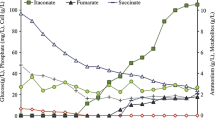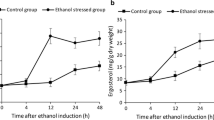Abstract
Characterization of the changes after various stimuli is crucial to comprehend the adaptation of cells to the changing condition. Aspergillus oryzae is widely used for the industrial production of soy sauce, which always encounter changes within a complex environment, such as salinity stress. However, the protective biochemical mechanisms of A. oryzae against salinity stress are poorly understood. In this study, we successfully characterized the fermentative behavior, transcriptomic profiles, and metabolite changes of A. oryzae in response to salinity stress. The results showed that salt treatment of A. oryzae inhibited the fungal development and conidia formation. Transcriptomic analysis showed an upregulated expression of the genes related to arginine accumulation and oleic acid synthesis. The results of qRT-PCR were further confirmed by the reliability and availability of the differentially expressed genes obtained from the transcriptome analysis. Metabolomic analysis revealed that the corresponding intracellular accumulation of arginine and oleic acid were also increased in response to the salinity stress. All of the results provide a global transcriptome characterization of the salt adaptation process in A. oryzae, and offer multiple target genes for salt tolerance improvement via genetic engineering.







Similar content being viewed by others
References
Arakawa T, Ejima D, Tsumoto K, Obeyama N, Tanaka Y, Kita Y, Timasheff SN (2007) Suppression of protein interactions by arginine: a proposed mechanism of the arginine effects. Biophys Chem 127(1–2):1–8
Audic S, Claverie JM (1997) The significance of digital gene expression profiles. Genome Res 7(10):986
Bähler J (2008) Tuning gene expression to changing environments: from rapid responses to evolutionary adaptation. Nat Rev Genet 9(8):583–593
Bajji M, Kinet JM, Lutts S (2002) The use of the electrolyte leakage method for assessing cell membrane stability as a water stress tolerance test in durum wheat. Plant Growth Regul 36(1):61–70
Bearson BL, Lee IS, Casey TA (2009) Escherichia coli O157: H7 glutamate- and arginine-dependent acid-resistance systems protect against oxidative stress during extreme acid challenge. Microbiology 155(3):805–812
Bechman A, Phillips RD, Chen J (2012) Changes in selected physical property and enzyme activity of rice and barley koji during fermentation and storage. J Food Sci 77(6):M318
Berg S, Edman M, Li L, Wikström M, Wieslander A (2001) Sequence properties of the 1,2-diacylglycerol 3-glucosyltransferase from Acholeplasma laidlawii membranes. Recognition of a large group of lipid glycosyltransferases in eubacteria and archaea. J Biol Chem 276(25):22056
Cheng XJ, He B, Chen L, Xiao SQ, Fu J, Chen Y, TQ Y, Cheng ZQ, Feng H (2016a) Transcriptome analysis confers a complex disease resistance network in wild rice Oryza meyeriana against Xanthomonas oryzae pv. oryzae. Sci Rep 6:38215
Cheng Y, Du Z, Zhu H, Guo X, He X (2016b) Protective effects of arginine on Saccharomyces cerevisiae against ethanol stress. Sci Rep 6:31311
Ghosh R, Sharma S, Chattopadhyay K (2009) Effect of arginine on protein aggregation studied by fluorescence correlation spectroscopy and other biophysical methods. Biochemistry 48(5):1135–1143
Gostinčar C, Turk M, Trbuha T, Vaupotič T, Plemenitaš A, Gunde-Cimerman N (2008) Expression of fatty-acid-modifying enzymes in the halotolerant black yeast Aureobasidium pullulans (de Bary) G. Arnaud under salt stress. Stud Mycol 61(1):51–59
Guan N, Liu L, Shin HD, Chen RR, Zhang J, Li J, Du G, Shi Z, Chen J (2013) Systems-level understanding of how Propionibacterium acidipropionici respond to propionic acid stress at the microenvironment levels: mechanism and application. J Biotechnol 167(1):56–63
Hazel JR, Williams EE (1990) The role of alterations in membrane lipid composition in enabling physiological adaptation of organisms to their physical environment. Prog Lipid Res 29(3):167
Hohmann S (2009) Control of high osmolarity signalling in the yeast Saccharomyces cerevisiae. FEBS Lett 583(24):4025–4029
Kol S, Merlo ME, Scheltema RA, Vries MD, Vonk RJ, Kikkert NA, Dijkhuizen L, Breitling R, Takano E (2010) Metabolomic characterization of the salt stress response in Streptomyces coelicolor. Appl Environ Microbiol 76(8):2574–2581
Long M, Li ZQ, Lei B, Cai XM, Luo ZX, Zhang YJ, Chen ZM (2016) Identification and comparative study of chemosensory genes related to host selection by legs transcriptome analysis in the tea geometrid Ectropis obliqua. PLoS One 11(3):e0149591
Martínez MF, Pascualahuir A, Proft M (2010) Toward a genomic view of the gene expression program regulated by osmostress in yeast. OMICS 14(14):619–627
Morsomme P, Boutry M (2000) The plant plasma membrane H(+)-ATPase: structure, function and regulation. Biochimica Biophys 1465(1–2):1
Mutnuri S, Vasudevan NM, Heipieper HJ (2005) Changes in fatty acid composition of Chromohalobacter israelensis with varying salt concentrations. Curr Microbiol 50(3):151–154
Norbeck J, Pâhlman AK, Akhtar N, Blomberg A, Adler L (1996) Purification and characterization of two isoenzymes of DL-glycerol-3-phosphatase from Saccharomyces cerevisiae. Identification of the corresponding GPP1 and GPP2 genes and evidence for osmotic regulation of Gpp2p expression by the osmosensing mitogen-activ. J Biol Chem 271(23):13875
O'Rourke SM, Herskowitz I (2004) Unique and redundant roles for HOG MAPK pathway components as revealed by whole-genome expression analysis. Mol Biol Cell 15(2):532
Rodriguez-Vargas S, Sanchez-Garcia A, Martinez-Rivas J, Prieto J, Randez-Gil F (2007) Fluidization of membrane lipids enhances the tolerance of Saccharomyces cerevisiae to freezing and salt stress. Appl Environ Microbiol 73(1):110
Samuel D, Ganesh G, Yang PW, Chang MM, Wang SL, Hwang KC, Yu C, Jayaraman G, Trivedi VD (2000) Proline inhibits aggregation during protein refolding. Protein Sci 9(2):344
Schneider CP, Shukla D, Trout BL (2011) Arginine and the Hofmeister series: the role of ion-ion interactions in protein aggregation suppression. J Phys Chem B 115(22):7447
Srivastava A, Singh SS, Mishra AK (2014) Modulation in fatty acid composition influences salinity stress tolerance in Frankia strains. Ann Microbiol 64(3):1315–1323
Sugiyama SI (1984) Selection of micro-organisms for use in the fermentation of soy sauce. Food Microbiol 1(4):339–347
Takagi H (2008) Proline as a stress protectant in yeast: physiological functions, metabolic regulations, and biotechnological applications. Appl Microbiol Biotechnol 81(2):211
Tasaka Y, Gombos Z, Nishiyama Y, Mohanty P, Ohba T, Ohki K, Murata N (1997) Targeted mutagenesis of acyl-lipid desaturases in Synechocystis: evidence for the important roles of polyunsaturated membrane lipids in growth, respiration and photosynthesis. EMBO J 15(23):6416–6425
Taymaznikerel H, Cankorurcetinkaya A, Kirdar B (2016) Genome-wide transcriptional response of Saccharomyces cerevisiae to stress-induced perturbations. Front Bioeng Biotechnol 4:17
Turk M, Méjanelle L, Sentjurc M, Grimalt JO, Gunde-Cimerman N, Plemenitas A (2004) Salt-induced changes in lipid composition and membrane fluidity of halophilic yeast-like melanized fungi. Extremophiles 8(1):53–61
Wang D, Zheng ZY, Feng J, Zhan XB, Zhang LM, JR W, Lin CC (2013) A high salt tolerant neutral protease from Aspergillus oryzae: purification, characterization and kinetic properties. Appl Biochem Microbiol 49(4):378–385
Wang H, Yong L, Yan L, Ke C, Dai X, Wan L, Wei G, Cheng L, Liao B (2015) Deep sequencing analysis of transcriptomes in Aspergillus flavus in response to resveratrol. BMC Microbiol 15(1):182
Weber MHW, Klein W, Lin M, Niess U, Marahiel MA (2001) Role of the Bacillus subtilis fatty acid desaturase in membrane adaptation during cold shock. Mol Microbiol 39(5):1321–1329
Xu S, Zhou J, Liu L, Chen J (2011) Arginine: a novel compatible solute to protect Candida glabrata against hyperosmotic stress. Process Biochem 46(6):1230–1235
You KM, Rosenfield CL, Knipple DC (2003) Ethanol tolerance in the yeast Saccharomyces cerevisiae is dependent on cellular oleic acid content. Appl Environ Microbiol 69(3):1499–1503
Zhang JT, Zhu JQ, Zhu Q, Liu H, Gao XS, Zhang HX (2009) Fatty acid desaturase-6 (Fad6) is required for salt tolerance in Arabidopsis thaliana. Biochem Biophys Res Comm 390(3):469
Zhao G, Yao Y, Chen W, Cao X (2013) Comparison and analysis of the genomes of two Aspergillus oryzae strains. J Agric Food Chem 61(32):7805–7809
Funding
This study was funded by the National Natural Science Foundation of China (NSFC) (Grant No. 31171731, 31700068 and 31460447), International S&T Cooperation Project of Jiangxi Provincial (Grant No. 20142BDH80003), General Science and Technology Project of Nanchang City (Grant No. 3000035402), “555 Talent Project” of Jiangxi Province, Jiangxi Province Science Foundation for Youths (20114BAB205039 and 20171BAB214004) and Science and Technology Research Project of Jiangxi Provincial Department of Education (Grant No. GJJ160765 and GJJ160794).
Author information
Authors and Affiliations
Corresponding author
Ethics declarations
Conflict of interest
The authors declare that they have no conflict of interest.
Ethical statement
This article does not contain any studies with human participants or animals performed by any of the authors.
Electronic supplementary material
ESM 1
(PDF 674 kb)
Rights and permissions
About this article
Cite this article
He, B., Ma, L., Hu, Z. et al. Deep sequencing analysis of transcriptomes in Aspergillus oryzae in response to salinity stress. Appl Microbiol Biotechnol 102, 897–906 (2018). https://doi.org/10.1007/s00253-017-8603-z
Received:
Revised:
Accepted:
Published:
Issue Date:
DOI: https://doi.org/10.1007/s00253-017-8603-z




